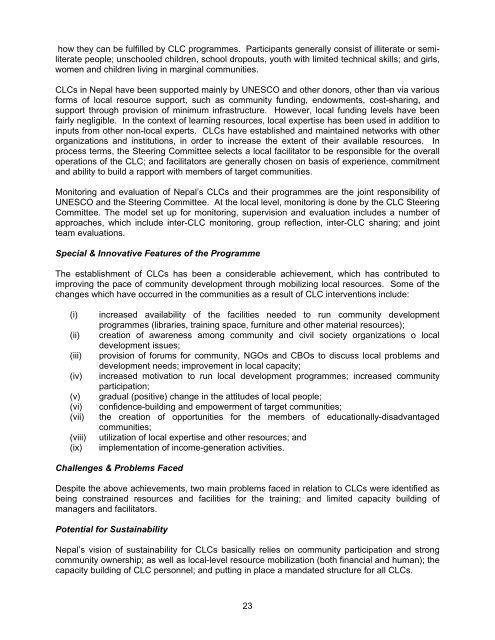(VLTs) are volunteers recruited by the CLC MC. They receive pre-service tra<strong>in</strong><strong>in</strong>g plus <strong>in</strong>-servicerefresher tra<strong>in</strong><strong>in</strong>g, based on APPEAL tra<strong>in</strong><strong>in</strong>g materials. CLCs may require other types of resourcepersons, such as experts <strong>in</strong> traditional medic<strong>in</strong>e, agriculture, traditional music <strong>and</strong> dance, <strong>and</strong> localh<strong>and</strong>icraft, a veter<strong>in</strong>ary or specialists <strong>in</strong> h<strong>and</strong>loom weav<strong>in</strong>g who can help <strong>in</strong> hold<strong>in</strong>g skills tra<strong>in</strong><strong>in</strong>gsessions. The philosophy for teacher tra<strong>in</strong><strong>in</strong>g was based on learner-centred methods, which is vitalfor the adult learners. The VLT is responsible for assess<strong>in</strong>g the learners’ achievements byobservation <strong>and</strong> by tests. The CLCs are multi-functional <strong>and</strong> an important strength is the explicit l<strong>in</strong>ksmade between education (literacy, post-literacy, NFPE), skills tra<strong>in</strong><strong>in</strong>g, dissem<strong>in</strong>ation of <strong>in</strong>formation<strong>and</strong> <strong>in</strong>come-generat<strong>in</strong>g activities. CLCs have helped improve education <strong>and</strong> <strong>in</strong>come opportunities,which have direct positive effects, both cultural <strong>and</strong> economic, on the quality of life, besidesgenerat<strong>in</strong>g <strong>in</strong>creased levels of confidence, coherence <strong>and</strong> collaboration <strong>in</strong> the target villages. Womenhave particularly benefited, s<strong>in</strong>ce their level of literacy is typically lower than that of men.Special & Innovative FeaturesThe implementation of the CLC component followed a rather unique approach, which differedfrom that of most other countries. One of the key persons <strong>in</strong> this structure was the CommunityLearn<strong>in</strong>g Coord<strong>in</strong>ator (CLCo), who was the l<strong>in</strong>k between the education project, the public sector<strong>and</strong> the communities via the Community Learn<strong>in</strong>g Organizer (CLO) <strong>and</strong> the CLC ManagementCommittee (CLC MC). The CLCo carries out a multitude of tasks <strong>in</strong>clud<strong>in</strong>g assist<strong>in</strong>g <strong>in</strong> capacitybuild<strong>in</strong>g of the CLCs; plann<strong>in</strong>g, organiz<strong>in</strong>g <strong>and</strong> monitor<strong>in</strong>g <strong>NFE</strong> <strong>and</strong> NFPE activities, skill tra<strong>in</strong><strong>in</strong>gfor learners; <strong>in</strong>come generat<strong>in</strong>g activities carried out by the communities; <strong>and</strong> record keep<strong>in</strong>g,supervision <strong>and</strong> monitor<strong>in</strong>g of CLC activities, as well as report<strong>in</strong>g back to the zonal specialist <strong>and</strong>the Assistant Programme Manager (APM).Challenges & Problems FacedMajor problems faced <strong>in</strong>clude: those of cater<strong>in</strong>g to an <strong>in</strong>creas<strong>in</strong>g number of school-go<strong>in</strong>g-age <strong>and</strong>out-of-school children, through <strong>NFE</strong> <strong>and</strong> CLC models; <strong>in</strong>creas<strong>in</strong>g the coverage rate; reach<strong>in</strong>g outthe very poorest communities; address<strong>in</strong>g <strong>in</strong>creas<strong>in</strong>g dem<strong>and</strong>; address<strong>in</strong>g a variety of susta<strong>in</strong>abilityissues; motivation of beneficiaries; the need for flexibility of activities; provid<strong>in</strong>g skill tra<strong>in</strong><strong>in</strong>g, lifeskills; issues of language diversity; f<strong>in</strong>ancial susta<strong>in</strong>ability; <strong>net</strong>work<strong>in</strong>g <strong>and</strong> partnerships; curriculum<strong>and</strong> material development; <strong>and</strong> availability of public sector support for future <strong>in</strong>itiatives.Potential for Susta<strong>in</strong>abilitySusta<strong>in</strong>ability is be<strong>in</strong>g enhanced through supportive community <strong>in</strong>itiatives; the use of volunteerismas well as of new methods of teach<strong>in</strong>g <strong>and</strong> lean<strong>in</strong>g <strong>in</strong> addition to conventional lectur<strong>in</strong>g, such as theuse of puppets, storytell<strong>in</strong>g, games, as well as practical work with projects <strong>and</strong> draw<strong>in</strong>gs.Case Study 10: Community Learn<strong>in</strong>g Centres, NepalBackground ContextIn Nepal, CLCs are a recent phenomenon. The Government's 10th Five-Year Plan <strong>in</strong>cludedCLCs as a key strategy for adult literacy <strong>and</strong> cont<strong>in</strong>u<strong>in</strong>g education, to provide access tolife skills <strong>and</strong> appropriate learn<strong>in</strong>g <strong>and</strong> life skills implementation opportunities; mak<strong>in</strong>gCLCs more accessible to people with disabilities; <strong>and</strong> encourag<strong>in</strong>g CLCs to use theexperience of older people <strong>and</strong> provid<strong>in</strong>g them with opportunities to learn <strong>and</strong> <strong>in</strong>teract withothers. The programmes conducted at CLCs <strong>in</strong>clude education, <strong>in</strong>come generation, women’sdevelopment, life skills tra<strong>in</strong><strong>in</strong>g, literacy, early childhood development (ECD), library services,sav<strong>in</strong>gs <strong>and</strong> credit, community forestry, preservation of the cultural heritage, <strong>and</strong> communitydevelopment. One of the objectives of the CLC concept is to enable communities to participatedirectly <strong>in</strong> plann<strong>in</strong>g, implement<strong>in</strong>g, evaluat<strong>in</strong>g <strong>and</strong> analyz<strong>in</strong>g their needs <strong>and</strong> <strong>in</strong>terests, <strong>and</strong>22
how they can be fulfilled by CLC programmes. Participants generally consist of illiterate or semiliteratepeople; unschooled children, school dropouts, youth with limited technical skills; <strong>and</strong> girls,women <strong>and</strong> children liv<strong>in</strong>g <strong>in</strong> marg<strong>in</strong>al communities.CLCs <strong>in</strong> Nepal have been supported ma<strong>in</strong>ly by UNESCO <strong>and</strong> other donors, other than via variousforms of local resource support, such as community fund<strong>in</strong>g, endowments, cost-shar<strong>in</strong>g, <strong>and</strong>support through provision of m<strong>in</strong>imum <strong>in</strong>frastructure. However, local fund<strong>in</strong>g levels have beenfairly negligible. In the context of learn<strong>in</strong>g resources, local expertise has been used <strong>in</strong> addition to<strong>in</strong>puts from other non-local experts. CLCs have established <strong>and</strong> ma<strong>in</strong>ta<strong>in</strong>ed <strong>net</strong>works with otherorganizations <strong>and</strong> <strong>in</strong>stitutions, <strong>in</strong> order to <strong>in</strong>crease the extent of their available resources. Inprocess terms, the Steer<strong>in</strong>g Committee selects a local facilitator to be responsible for the overalloperations of the CLC; <strong>and</strong> facilitators are generally chosen on basis of experience, commitment<strong>and</strong> ability to build a rapport with members of target communities.Monitor<strong>in</strong>g <strong>and</strong> evaluation of Nepal’s CLCs <strong>and</strong> their programmes are the jo<strong>in</strong>t responsibility ofUNESCO <strong>and</strong> the Steer<strong>in</strong>g Committee. At the local level, monitor<strong>in</strong>g is done by the CLC Steer<strong>in</strong>gCommittee. The model set up for monitor<strong>in</strong>g, supervision <strong>and</strong> evaluation <strong>in</strong>cludes a number ofapproaches, which <strong>in</strong>clude <strong>in</strong>ter-CLC monitor<strong>in</strong>g, group reflection, <strong>in</strong>ter-CLC shar<strong>in</strong>g; <strong>and</strong> jo<strong>in</strong>tteam evaluations.Special & Innovative Features of the ProgrammeThe establishment of CLCs has been a considerable achievement, which has contributed toimprov<strong>in</strong>g the pace of community development through mobiliz<strong>in</strong>g local resources. Some of thechanges which have occurred <strong>in</strong> the communities as a result of CLC <strong>in</strong>terventions <strong>in</strong>clude:(i)(ii)(iii)(iv)(v)(vi)(vii)(viii)(ix)<strong>in</strong>creased availability of the facilities needed to run community developmentprogrammes (libraries, tra<strong>in</strong><strong>in</strong>g space, furniture <strong>and</strong> other material resources);creation of awareness among community <strong>and</strong> civil society organizations o localdevelopment issues;provision of forums for community, NGOs <strong>and</strong> CBOs to discuss local problems <strong>and</strong>development needs; improvement <strong>in</strong> local capacity;<strong>in</strong>creased motivation to run local development programmes; <strong>in</strong>creased communityparticipation;gradual (positive) change <strong>in</strong> the attitudes of local people;confidence-build<strong>in</strong>g <strong>and</strong> empowerment of target communities;the creation of opportunities for the members of educationally-disadvantagedcommunities;utilization of local expertise <strong>and</strong> other resources; <strong>and</strong>implementation of <strong>in</strong>come-generation activities.Challenges & Problems FacedDespite the above achievements, two ma<strong>in</strong> problems faced <strong>in</strong> relation to CLCs were identified asbe<strong>in</strong>g constra<strong>in</strong>ed resources <strong>and</strong> facilities for the tra<strong>in</strong><strong>in</strong>g; <strong>and</strong> limited capacity build<strong>in</strong>g ofmanagers <strong>and</strong> facilitators.Potential for Susta<strong>in</strong>abilityNepal’s vision of susta<strong>in</strong>ability for CLCs basically relies on community participation <strong>and</strong> strongcommunity ownership; as well as local-level resource mobilization (both f<strong>in</strong>ancial <strong>and</strong> human); thecapacity build<strong>in</strong>g of CLC personnel; <strong>and</strong> putt<strong>in</strong>g <strong>in</strong> place a m<strong>and</strong>ated structure for all CLCs.23
















